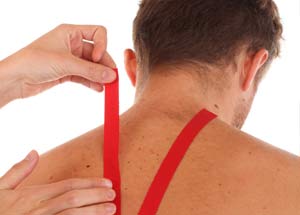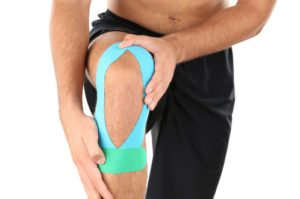
Myofascial taping

Myofascial taping to relieve and support the knee.
What is myofascial taping?
Myofascial taping is an innovative fascia taping technique that can often quickly treat and eliminate pain, dysfunctions and injuries in the musculoskeletal system (muscles, tissue and joints), as well as shortening and restricted movement.
For this purpose, a self-adhesive and highly flexible cotton tape is applied to the skin along the fascial line. The tape does not restrict movement, but facilitates and improves it. The tapes are dermatologically tested and generally last between four and seven days or even longer. As you can do sport, shower and swim with the tape on your skin, it does not restrict your daily routine.
Fascia taping predominantly results in an immediate improvement in pain symptoms and a shortening of the healing phase.
I only use Flexotape® for this, which is quite expensive compared to many kinesiotapes, but I think it is the best quality and was specially developed for myofascial taping techniques.
Myofascial taping is often used at the end of a treatment to support and maintain the progress of the treatment until the next appointment. However, it is also possible to apply fascial taping without prior body therapy treatment, especially for quick relief of pain, tension and injuries.
However, for a lasting effect and improvement in symptoms, I always recommend taping in conjunction with a previous myofascial connective tissue massage(rebalancing).
Areas of application
- Muscular pain and tension
- Back pain (lumbar spine, thoracic spine syndrome)
- Herniated disc (disc hernia)
- Shoulder and neck tension (cervical spine syndrome, whiplash)
- Heel spur
- Osteoarthritis and joint pain
- Rib fractures (to improve breathing)
- Pregnancy (to relieve the back)
- Acceleration of the recovery process after surgery (e.g. artificial knee or hip joint)
- Tinnitus
- Scolioses
- Headaches and migraines
- Treatment of scars
- Improvement of lymph flow (especially after surgery and injuries with lymph taping)
- Improvement and facilitation of movement patterns (also sport-specific),
and much more.

Pain star with fascia tape, e.g. for back pain, tension or slipped discs
History of the development of myofascial taping
Myofascial taping is a fascia taping method developed by Markus Erhard (Physio Training Academy) based on the latest findings in fascia research. It is often not the muscle that is the cause of pain and physical discomfort, but in almost 80% of cases of apparent muscular pain, its fascial sheath and the fascia surrounding it.
Markus Erhard has developed specific fascia tapping techniques that aim to address the properties of the movement and pain receptors of the fascia (Golgi, Pacini, Ruffini and interstitial receptors) via the skin and thus trigger corresponding sensory and fascial effects in the body. These receptors react, for example, to tension, pressure and tension ratios. This gave rise to the specific taping techniques used in myofascial taping, such as
- MRT - Myofascial release technique
i.e. where there is too much fascial tension, appropriate taping techniques are used to stimulate the fascial tissue via the skin and the underlying fascial structures to relax and let go. Too much tension is released. - MAC - Myofascial Activation Technique
i.e. where there is too little fascial tension, appropriate taping techniques are used to stimulate the fascial tissue to build up tension via the skin. This activates the fascia and muscle tissue. - Myofascial CENTER technique
i.e. centering and releasing the fascial tissue towards a pain point or area to create space, e.g. in the case of a slipped disc/disc hernia.
Myofascial taping is therefore more precisely a new, innovative fascia taping method that differs from classic kinesio taping in that myofascial taping takes into account the functional course of the fascia and the latest findings from fascia research and is "taped" accordingly. Kinesio taping is often still applied and taped according to muscle insertion and origin and with corresponding taping systems.

Fascia tape to relieve tension in the neck area
How myofascial taping works
Taping on the skin eliminates fascial and muscular imbalances. This is also referred to as "myofascial imbalances" (myo = muscle / fascia = connective tissue). This leads to an expansion and facilitation of movement and movement control, improved microcirculation (blood and lymph) and ultimately to pain relief and pain elimination. The mechanisms of action result from the mechanical treatment of the fascia and the resulting biomechanical and neuronal effects and not from the color of the tape.
The tape on the skin has the following effects:
- Myoascial release (relaxation of the fasciae)
- Normalization of the muscle tone
- Space creation (e.g. for compressed vertebrae, joints or intervertebral discs)
- Increasing the microcirculation of blood and lymph
- Stabilization and facilitation of movement sequences (e.g. for rib fractures and sports injuries)
Myofascial taping treatment procedure
1. brief interview: personal details, state of health or symptoms and complaints
2. if necessary, cleanse the skin with soapy water/sparkling wine (skin should be free of grease)
3. localization of the myofascial imbalances and any movement restrictions
4. application of the fascia tape to the skin
5. final discussion
Duration of treatment
Please allow sufficient time to arrive and for fascia tapping.
As a rule, myofascial taping on already degreased skin takes around 30 minutes, with a brief preliminary consultation and without prior treatment. The actual time depends on the size and number of taping areas required.
Myosfascial taping in conjunction with or during a body therapy treatment usually takes between 15-30 minutes, depending on the size and quantity of taping. The time set aside for this is included in the treatment time, or please allow an additional 15 minutes to your regularly booked treatment time.


